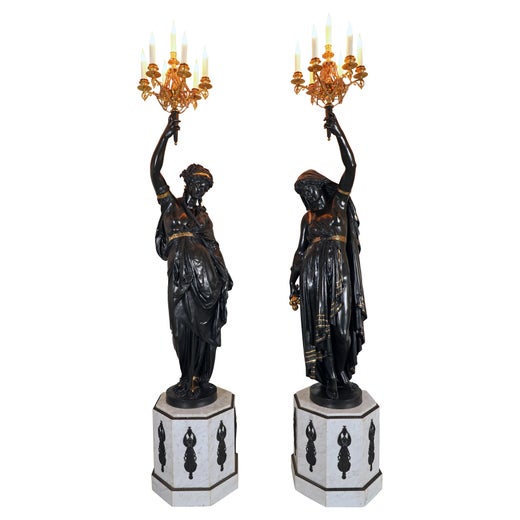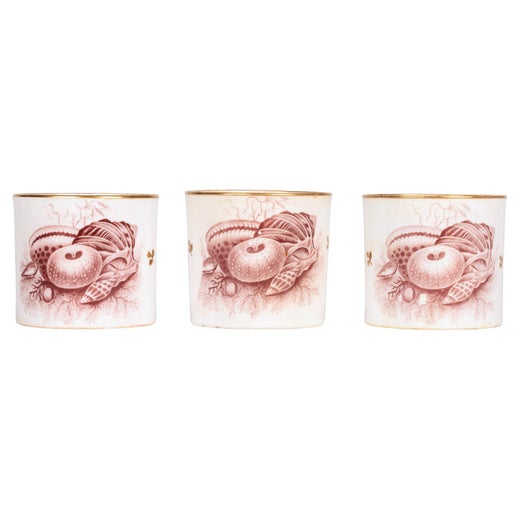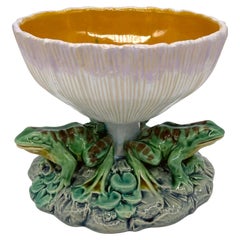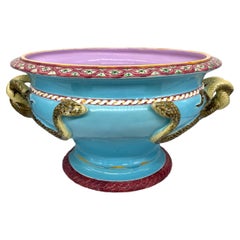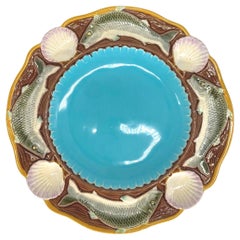Minton Majolica Faun Reticulated Basket by A. Carrier-Belleuse, Dated 1871
About the Item
- Creator:Minton (Maker),Albert-Ernest Carrier-Belleuse (Designer)
- Dimensions:Height: 6.25 in (15.88 cm)Width: 11 in (27.94 cm)Depth: 7 in (17.78 cm)
- Style:Victorian (Of the Period)
- Materials and Techniques:Majolica,Molded
- Place of Origin:
- Period:
- Date of Manufacture:1871
- Condition:Wear consistent with age and use.
- Seller Location:Banner Elk, NC
- Reference Number:Seller: WINhhet1stDibs: LU1302229431102
Albert-Ernest Carrier-Belleuse
Albert-Ernest Carrier-Belleuse was a French sculptor. Carrier-Belleuse was born on 12th June 1824 at Anizy-le-Château, Aisne, France. He began his training as a goldsmith's apprentice. He was a student of David d'Angers and briefly studied at the École des Beaux-Arts. His career is distinguished by his versatility and his work outside France, in England between 1850–55 and in Brussels around 1871. His name is perhaps best known because Auguste Rodin worked as his assistant between 1864 and 1870. The two traveled to Brussels in 1871 and by some accounts, Rodin assisted Carrier-Belleuse's architectural sculpture for the Brussels Stock Exchange.
Minton
Pottery is one of the oldest decorative art forms, and Minton is one of its historical masters. For more than 250 years, the English company was a premier producer of porcelain and ceramic wares. Its factory was known for detailed and brightly colored Victorian tableware, including dinner plates and serving pieces.
Thomas Minton founded the Minton factory in 1793 in Stoke-upon-Trent, England. It initially made earthenware but introduced bone china in 1798. When Minton died in 1836, the company passed to his son, Herbert Minton. The younger Minton was a savvy businessman with an eye for design. He introduced glossy majolica earthenware to the factory’s repertoire and hired skilled artists and designers like Augustus Welby Northmore Pugin and Albert-Ernest Carrier-Belleuse, boosting the company’s reputation.
In 1851, Minton debuted its majolica at the Great Exhibition in London. It became a royal family favorite and was even used to tile the Royal Dairy at Windsor Home Park. Minton majolica was also displayed on the monumental Saint George and the dragon fountain at the 1862 London International Exhibition.
Colin Minton Campbell, a nephew of Herbert Minton, took over the family business in 1858. He led the company to the head of the 1870s English art pottery movement. In the 1890s, French porcelain artist Marc-Louis Solon helped modernize Minton with his Art Nouveau designs.
Minton ceased operating as an independent company when it merged with Royal Doulton Tableware Ltd. in 1968. It was the end of an era, but not the end of widespread appreciation for Minton ceramics.
In 1982, the ”English Majolica” exhibition at the Cooper Hewitt, Smithsonian Design Museum featured 75 Minton pieces. When the Metropolitan Museum of Art reopened its British Galleries in 2020, it included a display of three colorful Minton majolica bird sculptures. Minton pottery was also on display from September 2021 to January 2022, along with other English pottery, at the Bard Graduate Center’s ”Majolica Mania” exhibition.
On 1stDibs, find exquisite Minton serveware, decorative objects, wall decorations and more.
You May Also Like
Antique 1860s English Victorian Ceramics
Maiolica
Antique 1890s French Rustic Decorative Baskets
Faience, Pottery
Antique Early 1900s French Romantic Decorative Baskets
Faience
Late 20th Century English Victorian Tea Sets
Majolica
Vintage 1920s French Art Nouveau Decorative Baskets
Ceramic, Faience
Antique 19th Century English Platters and Serveware
Ceramic, Earthenware, Pottery
Antique 1870s English Victorian Ceramics
Majolica
Antique 19th Century English Victorian Planters, Cachepots and Jardinières
Majolica
Antique 1870s English Victorian Serving Pieces
Earthenware, Majolica, Pottery
Antique Late 19th Century English Late Victorian Delft and Faience
Majolica
More From This Seller
View AllAntique 19th Century English Victorian Ceramics
Majolica
Antique 1850s English Victorian Ceramics
Majolica
Antique 19th Century English Victorian Ceramics
Majolica
Antique 19th Century English Victorian Ceramics
Majolica
Antique 19th Century English Victorian Ceramics
Majolica
Antique Mid-19th Century English Victorian Ceramics
Majolica
